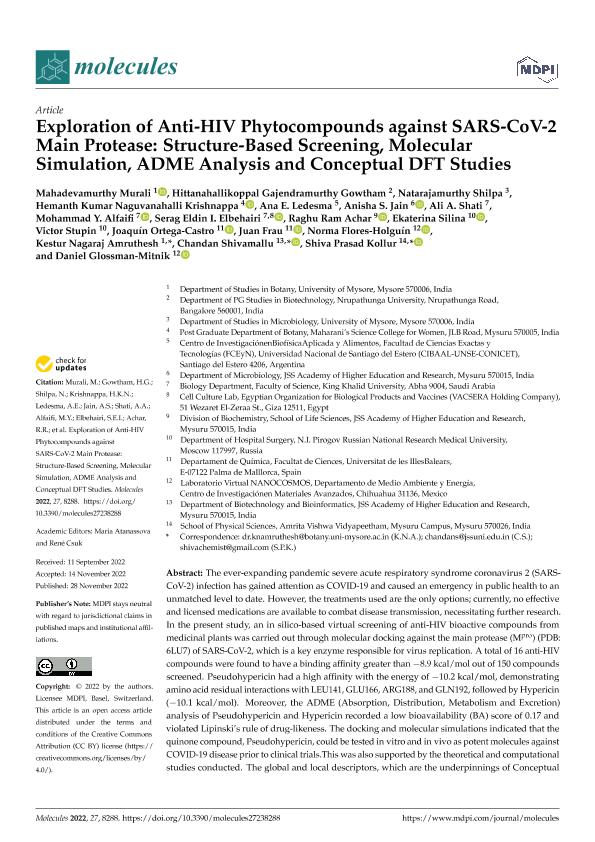Artículo
Exploration of Anti-HIV Phytocompounds against SARS-CoV-2 Main Protease: Structure-Based Screening, Molecular Simulation, ADME Analysis and Conceptual DFT Studies
Murali, Mahadevamurthy; Gowtham, Hittanahallikoppal Gajendramurthy; Shilpa, Natarajamurthy; Krishnappa, Hemanth Kumar Naguvanahalli; Ledesma, Ana Estela ; Jain, Anisha S.; Shati, Ali A.; Alfaifi, Mohammad Y.; Elbehairi, Serag Eldin I.; Achar, Raghu Ram; Silina, Ekaterina; Stupin, Victor; Ortega Castro, Joaquín; Frau, Juan; Flores Holguín, Norma; Amruthesh, Kestur Nagaraj; Shivamallu, Chandan; Kollur, Shiva Prasad; Glossman Mitnik, Daniel
; Jain, Anisha S.; Shati, Ali A.; Alfaifi, Mohammad Y.; Elbehairi, Serag Eldin I.; Achar, Raghu Ram; Silina, Ekaterina; Stupin, Victor; Ortega Castro, Joaquín; Frau, Juan; Flores Holguín, Norma; Amruthesh, Kestur Nagaraj; Shivamallu, Chandan; Kollur, Shiva Prasad; Glossman Mitnik, Daniel
 ; Jain, Anisha S.; Shati, Ali A.; Alfaifi, Mohammad Y.; Elbehairi, Serag Eldin I.; Achar, Raghu Ram; Silina, Ekaterina; Stupin, Victor; Ortega Castro, Joaquín; Frau, Juan; Flores Holguín, Norma; Amruthesh, Kestur Nagaraj; Shivamallu, Chandan; Kollur, Shiva Prasad; Glossman Mitnik, Daniel
; Jain, Anisha S.; Shati, Ali A.; Alfaifi, Mohammad Y.; Elbehairi, Serag Eldin I.; Achar, Raghu Ram; Silina, Ekaterina; Stupin, Victor; Ortega Castro, Joaquín; Frau, Juan; Flores Holguín, Norma; Amruthesh, Kestur Nagaraj; Shivamallu, Chandan; Kollur, Shiva Prasad; Glossman Mitnik, Daniel
Fecha de publicación:
11/2022
Editorial:
Molecular Diversity Preservation International
Revista:
Molecules
ISSN:
1420-3049
Idioma:
Inglés
Tipo de recurso:
Artículo publicado
Clasificación temática:
Resumen
The ever-expanding pandemic severe acute respiratory syndrome coronavirus 2 (SARS-CoV-2) infection has gained attention as COVID-19 and caused an emergency in public health to an unmatched level to date. However, the treatments used are the only options; currently, no effective and licensed medications are available to combat disease transmission, necessitating further research. In the present study, an in silico-based virtual screening of anti-HIV bioactive compounds from medicinal plants was carried out through molecular docking against the main protease (Mpro) (PDB: 6LU7) of SARS-CoV-2, which is a key enzyme responsible for virus replication. A total of 16 anti-HIV compounds were found to have a binding affinity greater than −8.9 kcal/mol out of 150 compounds screened. Pseudohypericin had a high affinity with the energy of −10.2 kcal/mol, demonstrating amino acid residual interactions with LEU141, GLU166, ARG188, and GLN192, followed by Hypericin (−10.1 kcal/mol). Moreover, the ADME (Absorption, Distribution, Metabolism and Excretion) analysis of Pseudohypericin and Hypericin recorded a low bioavailability (BA) score of 0.17 and violated Lipinski’s rule of drug-likeness. The docking and molecular simulations indicated that the quinone compound, Pseudohypericin, could be tested in vitro and in vivo as potent molecules against COVID-19 disease prior to clinical trials.This was also supported by the theoretical and computational studies conducted. The global and local descriptors, which are the underpinnings of Conceptual Density FunctionalTheory (CDFT) have beenpredicted through successful model chemistry, hoping that they could be of help in the comprehension of the chemical reactivity properties of the molecular systems considered in this study.
Palabras clave:
ANTI-HIV
,
BIOACTIVE COMPOUNDS
,
CONCEPTUAL DFT
,
MAIN PROTEASE
,
SARS-COV-2
,
COVID-19
Archivos asociados
Licencia
Identificadores
Colecciones
Articulos (CIBAAL)
Articulos de CENTRO DE INVESTIGACION EN BIOFISICA APLICADA Y ALIMENTOS
Articulos de CENTRO DE INVESTIGACION EN BIOFISICA APLICADA Y ALIMENTOS
Citación
Murali, Mahadevamurthy; Gowtham, Hittanahallikoppal Gajendramurthy; Shilpa, Natarajamurthy; Krishnappa, Hemanth Kumar Naguvanahalli; Ledesma, Ana Estela; et al.; Exploration of Anti-HIV Phytocompounds against SARS-CoV-2 Main Protease: Structure-Based Screening, Molecular Simulation, ADME Analysis and Conceptual DFT Studies; Molecular Diversity Preservation International; Molecules; 27; 23; 11-2022; 1-16
Compartir
Altmétricas



